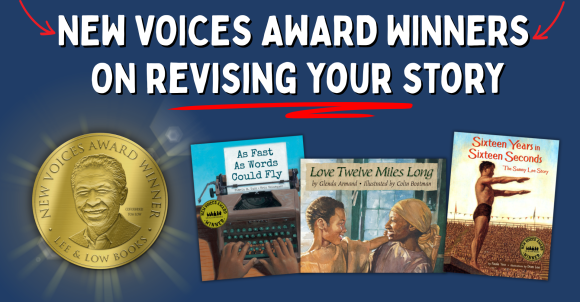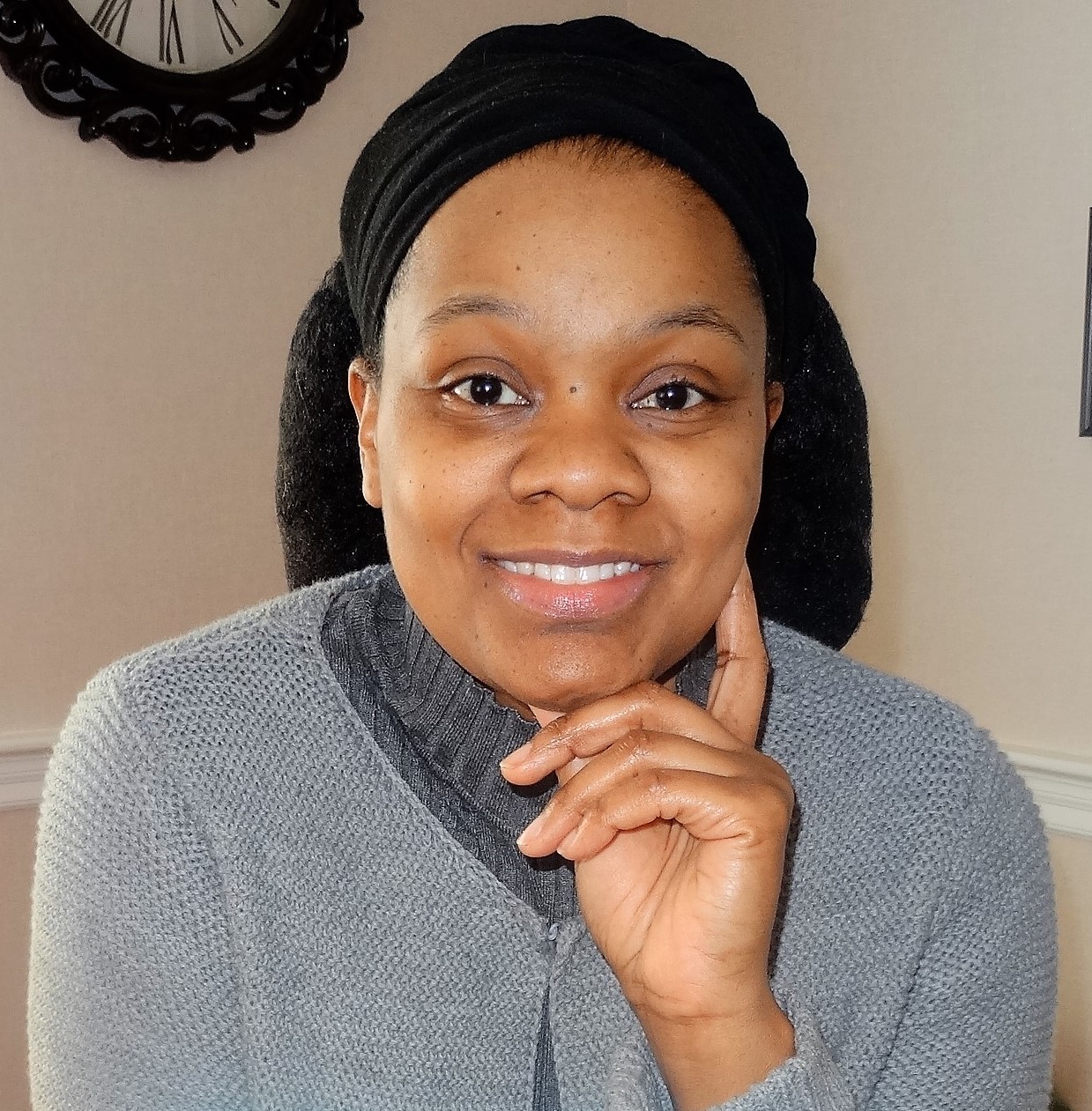This year marks our sixteenth annual New Voices Award, Lee & Low’s writing contest for unpublished writers of color.
In this blog series, past New Voices winners gather to give advice for new writers. This month, we’re talking about one of the most important steps in writing a story: revision.
Pamela Tuck, author of As Fast As Words Could Fly, New Voices Winner 2007
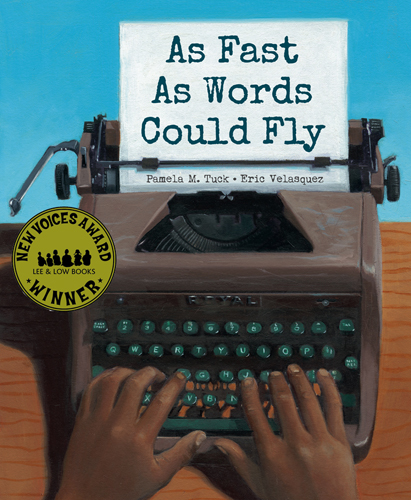
by Pamela Tuck and illustrated by Eric Velasquez
WATCH THE STORYLINE ONLINE READING OF THE BOOK WITH ACTOR DULÉ HILL
"From the beautiful cover picture of the boy's fingers on the typewriter keys, to the ugly view of the racist bus driver who tells the black pupils to 'get to the back,' Velasquez's handsome oil paintings on watercolor paper bring close the details of one boy's struggle. Told from a personal viewpoint and appended with a powerful author's note, this is a story to share across generations." —Booklist
The first tip I would like to give new writers about revision is to understand that there is a difference between revising, editing, and proofreading. Editing and proofreading cover word economy, word choices, and grammatical errors. But true revision runs deeper. Revision is Rethinking, Reseeing, and Reworking your ideas, your voice, and your plot into an engaging masterpiece.
After I’ve written my first draft, I already know that it’s going to be BAD. Too wordy, somewhat disconnected, and possibly even confusing. The idea of it all is to capture those fast and furious and jumbled thoughts on paper in some sort of order, and then mold and shape them into a sensible, readable, and hopefully publishable manuscript.
One of my first steps in revision is making sure I have a steady flow to my storyline. I’m looking for a beginning to hook my reader, a middle to engage them, and a satisfactory ending. I try to make sure I’ve provided explanation to possible questions my readers may have by using subtle descriptions, active verbs, and concise word choices that will paint the best pictures and explain my thoughts. Once my story has taken shape, I call in my “critical crew” (family and friends) to read my first draft. Reading out loud helps me hear my mistakes and/or thoughts and also highlights areas that may not be as clear to the reader as I thought. I can also tell from my critical crew’s feedback, whether or not my writing is making the impact I desire it to make. After pouring my heart out and letting it get “trampled” on by loving, supportive family and friends, it’s time to let the story (and my heart) rest for a while (a few days, a week, a month, or however long it takes). This “waiting period” is a good time to do further research on your topic (if applicable) just in case you run across a fresh idea or different aspect that can be added to enhance the story during the second revision stage.
During the next stage of revision, I’m able to read my manuscript with “fresh eyes.” I try to make sure that what I’ve written says what I want it to say in a way the reader will understand. Then I try to perfect my voice and dialogue to make sure they are as realistic and powerful as they can be. This is when I pull in those editorial and proofreading skills, to challenge myself with better word choices and sentence structures that will give the effect I’m looking for. I incorporate any new research ideas that may clarify or give a little more detail to vague thoughts or ideas. Then it’s time to call in the critical crew again. After another round of reading aloud and analyzing, I repeat the process over and over again, until I feel satisfied with my manuscript as a writer, and the critical crew leaves my heart feeling elated.
Paula Yoo, author of Sixteen Years in Sixteen Seconds, New Voices Winner 2003
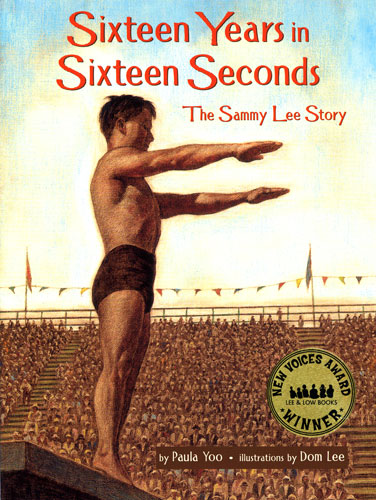
by Paula Yoo and illustrated by Dom Lee
ASIAN/PACIFIC AMERICAN AWARD FOR LITERATURE (APALA) WINNER
⭐TWO STARRED REVIEWS⭐
⭐"[A] handsome, inspiring biography, which will make both an excellent read-aloud for younger children or a read-alone for confident older ones." —Booklist, starred review
Are you sure you want to see my self-revision process? I’m going to warn you now. It’s really messy. I mean, SUPER MESSY.
There are two stages of revision for me. For REVISION STAGE 1.0, I spend the majority of time just brainstorming. NO actual writing is involved, other than jotting down casual notes. I ask myself tough questions about character motivation, emotional journeys, and voice. I brainstorm a storyline or plot based on what I discover about my character’s journey. This includes using index cards and outlines. For old school longhand, I use both yellow legal pads with a clipboard and my trusty Moleskine notebook. When I’m on my MacBook laptop or iPad, I use my favorite writing software apps – Scrivener, Scapple, Index Card, and Omm Writer.
So during the brainstorming time, I’m actually constantly revising as I free-associate and slowly build, tear down, and rebuild the structure for my story. This Revision Stage 1.0 of brainstorming is a writing process I was taught as a professional TV drama writer/producer. In TV, writers are not allowed to write the first draft of a script until they have brainstormed the story beats non-stop and have crafted a detailed, solid outline in which every single story point and character emotional arc has been mapped out completely.
Once I’m done with this brainstorming/revision session, I write. There’s no revision here. I just write straight from the heart. It’s raw and messy and inspired.
THEN I enter REVISION STAGE 2.0. This is where I print out what I wrote, find my favorite coffeehouse or library, and curl up on a comfy sofa chair or take over a library study carrel or coffeehouse corner table, and whip out the red pen. Yes, I use red ink. I wear glasses (bifocals too!), so red is just easier for me to read.
I simultaneously line edit (based on my former life as a newspaper and magazine journalist) and also jot down revision notes for the Bigger Picture. Some Bigger Picture revision questions include: Does the character’s inner personality and struggle organically inspire every single plot point and twist in the storyline? Do the story beats align in a logical and structured manner? Is there any “on the nose” dialogue I can tweak to be more natural sounding and even subtextual? Have I grounded the setting in each scene? And so on.
I also handwrite new lines or ideas or snippets of dialogue that float into my brain as I revise.
Once I’m done with this red pen marking mess, I then input everything into the computer in a new file (either a new folder in Scrivener or a new document in Word). Then I make a copy of that revised file and add a new date to it and start fleshing that version out more on the computer.
Then I move onto writing new material (either new scenes or chapters). When I’m stuck or need a break or want to pause and re-examine the new stuff I’ve just written, I print everything out and grab the red pen. Rinse and repeat. 🙂
In other words, I’m constantly revising. I’m never not revising. I told you, my self-revision process was messy! But it’s worth it in the end when a beautiful book rises out of that big crazy messy pile of red pen marks. 🙂
Glenda Armand, author of Love Twelve Miles Long, New Voices Winner 2006
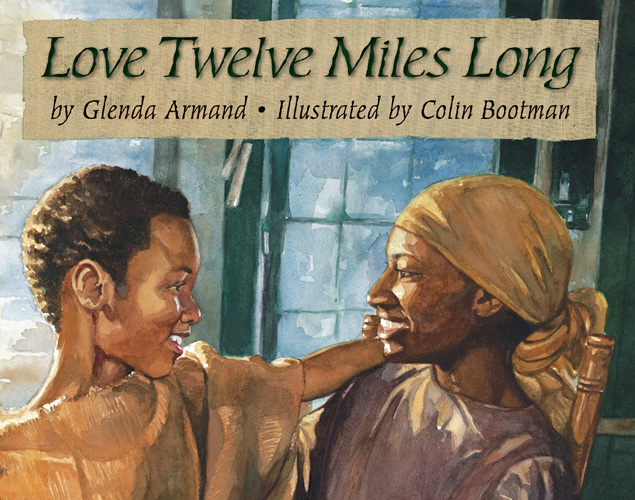
by Glenda Armand and illustrated by Colin Bootman
"This poignant story, based on Frederick Douglass's childhood, tells how his mother, a slave, would walk twelve miles at night for a brief visit with her son. Soothing text describes how she overcomes the monotony and loneliness through songs (joyful and sad), the solace of prayer, and love. Emotional paintings capture moods, especially the joy of reunion that wipes away weariness." —The Horn Book
Once I have completed the first draft of a picture book, I put it away and start working on another manuscript.
I go back to the first manuscript and read it with fresh eyes. As I read it, I make changes. I read it again and again, over the course of days, each time making changes, big and small.
Once I can read the whole thing, without making a single change, I know that it is almost there! I put it away again.
When I come back to it and can read it again without revising, I give it to my sister, Jenny, the retired librarian, to read.
I tell her that I think it is perfect and that she is not going to find a single thing that needs to be changed. Jenny gives me a smug look and says, “Okay.”
Later, we get together and she offers her ideas and critiques. I get annoyed. Why? Because her suggestions are always spot on. I revise based on her opinions, and it always makes the manuscript better (I admit reluctantly). I keep revising until we both think it is perfect. At that point, I am ready to send it to my agent. She usually offers ideas from her unique perspective that I take into account and revise the manuscript again.
I actually enjoy revising. I appreciate the input of my agent, editor—and my sister (but don’t tell her. It will go to her head).








